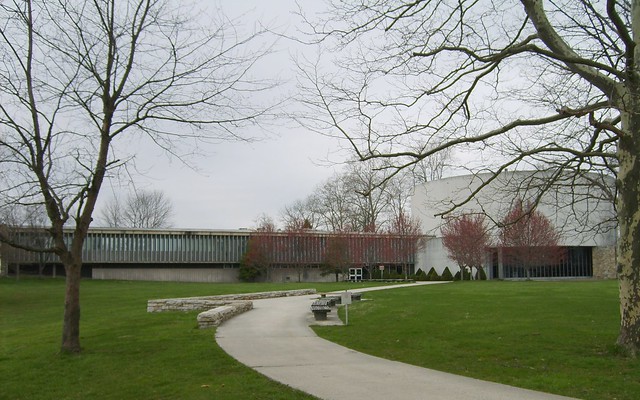The fifth building down was the Cyclorama Building at Gettysburg National Military Park. The building was constructed in 1962 (just one year before the battle's centennial) by modernist architect Richard Neutra to house an amazing 360-degree painting of the battle created in 1883.
 |
| Cyclorama Building, Courtesy Flickr |
 |
| Overhead view of the building. Courtesy Modisabi. |
In 2005, the painting was removed from the building for conservation work. In 2008, the painting was installed in the brand new visitor center. With the painting now conserved and hanging in a new location, the Cyclorama Building, which was built specifically for the painting, was obsolete.
Both the Cyclorama Building and the old visitor center (demolished in 2008) were built on key parts of the battlefield. Their modern intrusion onto the landscape disrupted the ability to see and connect with what actually happened there during three hot days in July 1863.
 |
| Sticking out like a sore thumb. Courtesy NPS. |
Admittedly, it was a huge mistake for the National Park Service to have built them there in the first place. That said, this was during their 50th anniversary "Mission 66" phase and they built a lot of weird crap in places they shouldn't have in parks all over the country during that time.
There were no plans to reuse the Cyclorama Building for any other purpose by the NPS - and why should they? It no longer served the purpose for which it was built and it was an imposition to interpretation goals that are vital to the park and its main purpose.
The decision was made to demolish the building. Critics of the demolition claimed that it was vital to retain the building because it was an example of Neutra's modernist work. OK, that's all good and well, but let's play a game. It's called "One Of These Things Is Not Like The Other." I'm going to give you a list of words and you tell me which one doesn't belong. Simple, right? I'm sure you can handle it. OK, here we go:
Gettysburg. Civil War. Modernist. 1863.
Did you find which one doesn't belong? Most people can plainly see that "Modernist" is the word that doesn't belong here. Unfortunately, some people felt that all four of those went together just fine.
Ugh.
Fast forward to March 2010. The Cyclorama Building has been sitting vacant since 2005 - five whole years. Do you know what happens to a building when it sits vacant with no maintenance for five years? It begins to fall apart. Just like an abandoned house or car in a field, after five years, nature begins to reclaim the land. The infrastructure is no longer sound and it will cost a ton of money to bring it back to a usable state.
Demolition by neglect? Absolutely. Planned all along? You bet. The wrong thing to do? No way.
Back to March 2010. I was working for the NPS and was doing a detail with the Northeast Regional Office's regional architect. Our task was to complete the ratings on the park's List of Classified Structures (LCS) to see how things were holding up in the park. At Gettysburg, this includes things like monuments, cannons, roads, ... and buildings. This included the Cyclorama Building.
As I mentioned, it had been sitting vacant for five years and was in rough shape. Now, I'm a preservationist by training and I absolutely love historic structures. (Which, I might add, the Cyclorama Building can be considered since it is more than 50 years old. That said, it was not classified as a "contributing structure" to the battlefield for obvious reasons.) So this is where you might find what I'm about to say as contradictory and blasphemous. Are you ready?
I rated the building in poor condition. That rating, combined with the lack of a plan for the structure, no doubt led to its demolition in March 2013. And you know what? I'm proud of that. That's right. I'm proud of my rating that likely helped get the Cyclorama Building torn down. Why? Because it doesn't fit the mission at Gettysburg! That building had nothing to do with the Civil War!
Gettysburg Superintendent Bob Kirby says that Gettysburg is "a symbol of America's struggle to survive as a nation and as a lasting memorial to the armies and soldiers who served in that great conflict." Do you see anything in there about preserving the modernist designs of architect Richard Neutra? No? Neither do I.
When the building came down in March 2013, it made the news. Some people were pissed. But me? I sat back and smiled, knowing that I had helped play a part - however small - in making that happen.
 |
| Cyclorama Building during demolition. Courtesy Flickr. |
Now that the building is gone, the NPS can focus on returning the land to the way it looked in July 1863. And really, as we sit here just the other side of Gettysburg's 150th anniversary and entering the fourth year of the Civil War's sesquicentennial, what better way is there to honor the brave men on both sides who fought and died there than by returning the land to its original appearance? I can't think of any.







.jpg)










